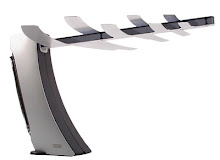An electrical device designed to receive and transmit electromagnetic waves is called an antenna. Antennas are commonly used in radio, television broadcasting, cell phones, radar and other systems involving the use of electromagnetic waves. Since electromagnetic waves can pass thru any medium at a certain frequency, this simply means that antennas can work not only in air but also under water and even thru solid ground. An antenna is also defined as an arrangement of conductors that generate electromagnetic field as a reaction to applied alternating electrical current or induce an alternating current between its terminals when placed in an electromagnetic field.
The word antenna became popular because of Guglielmo Marconi, an Italian scientist. Marconi was testing experimental wireless equipment in the Alps of Salvan, Switzerland way back in 1895. A tent pole in Italian is called l'antenna centrale and Marconi was using the term antenna to describe the pole that serves as the transmitting and receiving elements of his wireless equipment. Today, the term used by Marconi is now being used uniformly to refer to this type of equipment. Antennas are usually intended for communication applications involving radio waves. Although other communicating systems that utilize electromagnetic waves other than radio waves still use antenna to refer for their transmitting and receiving elements.
There are two basic types of antennas. The omni-directional antenna radiates electromagnetic signal equally in the three dimensional plane while the directional antenna radiates the signal more in one direction. Adding conducting elements such as a rod or a coil and varying their spacing, direction and length can create a specific antenna with specific properties. By connecting several antennas to a common source, it becomes an antenna array that has a directive radiation pattern. The conductive means for conveying signal energy between the active antenna and the source is called antenna lead-in while the components between an amplifier and the active antenna is called antenna feed.
There are certain parts of an antenna that perform a distinct function. A few of these parts are the reflector and director. The reflector is usually a metallic plate or screen that reradiates the electromagnetic radiation coming from or going to the active antenna and adding a component in an opposite direction to the velocity of the interrupting electromagnetic wave. The director on the other hand, works in a similar manner but adds a component on the same direction to the velocity of the interrupting electromagnetic wave. Most antennas are made up of simple vertical rods. These simple antennas are inexpensive and are omni-directional with respect to the horizontal plane. However, the direction that the rod is pointing at is a null area where the antenna can't receive or transmit. Theoretically, signals transmitted by an antenna can travel at great distances and at the speed of light. In reality, the speed of the signal is affected by the medium it is passing thru. Radio waves can even penetrate solid materials such as a non-conducting wall. Some solid materials however, may totally reflect the signal and in essence, not allowing it to pass through.
Michael Russell
Your Independent guide to Antennas
Article Source: http://EzineArticles.com/?expert=Michael_Russell

Antenna Basics
Subscribe to:
Post Comments (Atom)

0 comments:
Post a Comment